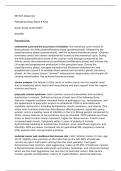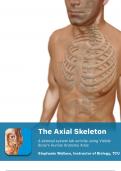NR-507 Advanced
Pathophysiology Week 8 Final
Exam Study Guide 100%
SOLVED
Reproductive:
endometrial cycle and the occurrence of ovulation- the menstrual cycle consist of
three phases: the follicular/proliferative phase (postmenstrual), followed by the
luteal/secretory phase (premenstrual), and the ischemic/menstrual phase. *Ovarian
hormones control the uterine (endometrial) events of the menstrual cycle. During
the follicular/proliferative phase of the ovarian cycle estrogen produced by the
follicle causes the endometrium to proliferate (proliferative phase) and induces the
LH surge and progesterone production in the granulosa layer. During the
luteal/secretory phase, estrogen maintains the thickened endometrium, and
progesterone causes it to develop blood vessels and secretory glands (secretory
phase). As the corpus luteum “starved” endometrium degenerates and sloughs off,
causing menstruation, the ischemic/menstrual phase.
uterine prolapse- the descent of the cervix or entire uterus into the vaginal canal
due to weakened pelvic fascia and musculature and poor support from the vaginal
muscles and fascia.
polycystic ovarian syndrome- most common cause of anovulation and ovulatory
dysfunction in women. Defined as having at least two of the following three
features: irregular ovulation, elevated levels of androgens (e.g., testosterone), and
the appearance of polycystic ovaries on ultrasound. PCOS is associated with
metabolic dysfunction, including dyslipidemia, insulin resistance, and obesity. One
of the most common endocrine disturbances affecting women, especially young
women, and is a leading cause of infertility in the U.S. Strong genetic component to
PCOS, various features of the syndrome may be inherited. PCOS patients are three
times as likely to have insulin resistance, higher for obese women. Tend to have
increased leptin levels. Symptoms within 2 years of puberty & include:
dysfunctional bleeding or amenorrhea, hirsutism, acne, acanthosis nigricans, and
infertility. 60% are obese. Increased risk for gestational DM, pregnancy-induced
HTN, preterm birth, and perinatal mortality.
testicular cancer and conditions that increase risk- most common cancer in men, age
15-35. Slightly more common on the right than on the left. 90% of testicular
cancers are germ cell tumors arising from the male gametes. Two types:
Seminomas-most common, least aggressive, make up 30-35% of testicular cancers
& Nonseminomas-include embryonal carcinomas, teratomas, and choriocarcinomas,
which are the most aggressive, but rare form of testicular cancer. Risk factors
include: genetic predisposition, history of cryptorchidism, abnormal testicular
,development, HIV, AIDS, Klinefelter syndrome, and history of testicular cancer. Can
arise from specialized cells of the gonadal stroma-these tumors, which are named
for their cellular origins, are Leydig cell, Sertoli cell, granulosa cell, and theca cell
tumors and constitute less than 10% of all testicular cancers.
,symptoms that require evaluation for breast cancer- painless lump, palpable nodes in
the axilla, retraction of tissue (dimpling), chest pain, dilated blood vessels, edema,
edema of the arm, hemorrhage, local pain, nipple/areolar eczema, nipple discharge
in non-lacting woman, pitting of the skin (like surface of an orange peel), reddened
skin, local tenderness and warmth, skin retraction, ulceration.
signs of premenstrual dysphoric disorder- One of these symptoms must be present
for a diagnosis: marked affective lability, marked irritability or anger or increased
interpersonal conflicts, marked anxiety, tension. One of these must also be present:
decreased interest, difficulty concentrating, easy fatigability, low energy, increase
or decrease in sleep, feelings of being overwhelmed, physical symptoms, such as:
breast tenderness, muscle or joint aches, bloating or weight gain. (Greater than 5 of
these symptoms occur during the week before menses onset, improve within a few
days after menses onset, and diminish in the week postmenses).
dysfunctional uterine bleeding- bleeding that is abnormal in duration, volume,
frequency, or regularity; and has been present for the majority of the previous 6
months. May be acute or chronic. PALM-COEIN System for classification of abnormal
uterine bleeding: PALM-structural causes: Polyp, Adenomyosis, Leiomyoma,
Malignancy. COEIN-nonstructural causes: coagulopathy, ovulatory dysfunction,
endometrial, iatrogenic, not yet classified. Increased endometrial bleeding is
correlated with a change from ovulatory to anovulatory cycles due to high estrogen
levels.
pathophysiology of prostate cancer- More than 95% of prostatic neoplasms are
histologically similar to adenocarcinomas and rely on androgen-dependent
signaling for their development and progression. Most of these neoplasms occur in
the periphery of the prostate. Prostatic adenocarcinoma is a heterogeneous group
of tumors with a diverse spectrum of molecular and pathologic characteristics, and
therefore clinical behaviors and challenges. The biologic aggressiveness of the
neoplasm appears to be related to the degree of differentiation rather than the size
of the tumor. Testicular testosterone provides the main source of androgens in the
prostate and is the major circulating androgen, whereas DHT predominates in
prostate tissue and binds to the androgen receptors with greater affinity than does
testosterone. Androgen production outside of the testes, or extra testicular
sources. Testosterone is converted to dihydrotestosterone, DHT is the most potent
intraprostatic androgen.
HPV and the development of cervical cancer- almost exclusively caused by cervical
human papillomavirus (HPV) infection. HPV strains 16 & 18 are most often
implicated as causing 70% of all cervical cancers and also contribute to many
vaginal, vulvar, penile, anal, and oropharyngeal cancers. Most HPV infections are
cleared from the immune system; vast majority of infections do not cause cervical
cancer. Screening before age 21 not recommended. Women with multiple sex
partners are more likely to be exposed to high-risk HPV, but women with only one
lifetime sexual partner can also become infected. Transformation zone is where the
two cell types of squamous epithelium cells and columnar epithelial cells come
together and this is where carcinoma in situ is most likely to develop. PAP test or
, HPV screening necessary for early





